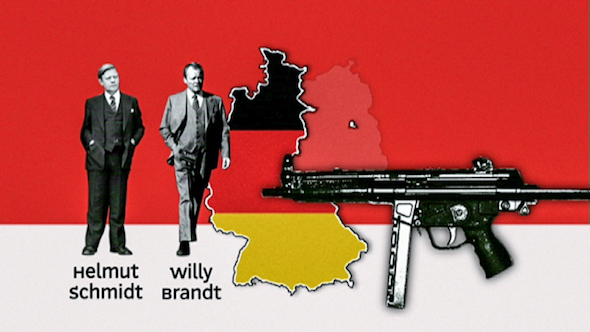I’ve been reading Alexander Sedlmaier’s Consumption and Violence: Radical Protest in Cold War West Germany. I picked it up after seeing it in the Cambridge University Press catalog, and only subsequently did I realize that I’d seen Sedlmaier give quite an interesting presentation at a German Studies Association conference in New Orleans long ago. In any case, I’ll have more to say about the book itself below, but the book, and the memory have reminded me about some of the problems that troubled the left in the 20th century, and continue to bedevil it today.
Since I left academia, it is now more rare that I come into contact with people who venerate the violent radicals of the 1960s. But it does happen occasionally, and few things have such a capacity to enrage. Some of the people associated with the radical fringes of the West German Left (and it’s this history with which I am best acquainted) did engage in positive and well-considered attempts to forge connections between the various segments of the working classes and radical thinkers among the students and academics in order to promote the struggle against capitalism. But by the mid-1960s they were very much in the minority.
It is a sad fact that proletarian solidarity was at a particularly low ebb for the vast majority of the era since the Second World War. To a great extent this was due to the extension of the blandishments of consumer culture to the working masses of the (so-called) First World, which made life under the auspices of liberal capitalism seem quite a lot more bearable than it had to previous generations. For a range of the reasons, it was pretty clear that there remained a deep gulf between anticapitalist radicals and the proletariat. But rather than engage in the slow, often thankless, often boring process of incremental organization, the West German radicals of the 1960s all too often made the same mistake Lenin did (with even less justification) and followed his lead off into the morass of a revisionism that vitiated Marx’s ideas.
At this point, for the sake of clarity, let me put forward a few theses:
1. Leninism is a world away from the views of Marx. Lenin’s insistence that the proletariat can only ever reach trade union consciousness may or may not be true, but it is fundamentally at variance with Marx’s position, as is the self-indulgent reliance on vanguardism.
2. In Lenin’s case there was at least some sort of justification for deviating in this way: Tsarist Russia was a predominantly agrarian society with little to speak of in terms of an industrial proletariat. If there were going to be a revolution in the lifetimes of Lenin and his Bolshevik allies, it would require the reconfiguration of Marx’s historical narrative. Sadly, one consequence of this was the perceived need for catastrophic violence in order to fit the square political peg in the round historical hole. Another consequence of this was Stalinism.
3. Unlike Lenin, the West German radicals of 1968 lived in an industrialized society with a large and complex working class. In light of this, there was even less justification for the explosive vanguardism of groups like the Rote Armee Faktion, the Umherschweifende Haschrebellen, the Bewegung 2. Juni, the Revolutionäre Zellen/Rote Zora, or any of the various autonomist and spontanist groups that formed in the late 1960s and early 1970s.
4. Engaging in shootouts with the cops is stupid. And counterrevolutionary. And brutal. And likely to result in your death or serious injury. But, most importantly, it’s stupid. Herbert Marcuse got this absolutely right in an article published in Die Zeit in September 1977 and is worth quoting at length:
The physical liquidation of single individuals, even the most prominent, does not undermine the normal functioning of the capitalist system itself. On the contrary, it strengthens its repressive potential without (and this is the decisive point) either engendering opposition to oppression or raising political consciousness.
Obviously the victims of terrorist actions represent the system – but they only represent it. That is to say, they are replaceable and exchangeable. The reservoir for recruiting their replacements is practically unlimited. In view of the overwhelming disproportion between the concentrated power of the state machine and the weakness of terrorist groups isolated from the masses, the attempt to create uncertainty and anxiety among members of the ruling class is hardly a revolutionary accomplishment. Given the prevalent conditions in the Federal Republic (the situation of preventive counter-revolution), it is destructive for the Left at this time to provoke the power of the state.
5. Using bombs as a means of political expression is seldom a good idea under any circumstances. Over and above the fundamental brutality of killing and maiming other human beings (an outcome that even the greatest caution in execution cannot entirely exclude), the aggregate effect is pretty much invariably counterrevolutionary for the reasons mentioned in the previous point. When things explode, the state as the notionally exclusive source of “legitimate” violence is then provided with a justification for exerting pressure on anyone whose views deviate from the bourgeois mainstream. The results are regressive. The RAF’s “if we bomb it they will come” theory of revolutionary organization was an attempt (simultaneously brutal and utterly ridiculous) to deflect attention from their fundamental separation from the masses and their complete failure in terms of understanding revolutionary subjectivity.

6. Firebombing synagogues, especially in Germany, is so stupid as to beggar belief. Irrespective of how one feels about Zionism, there is simply no excuse for this. The inability of all too many radical leftists in West Germany (and elsewhere) to understand the historical significance of Nazism as a historical precursor to the West German state (and to postwar Europe generally) represents a failure of political analysis that is simply unacceptable.
7. Similarly, if less, horrifically, smashing shop windows and pouring butyric acid on commodities does not amount to a blow against the prevalence of consumer culture. The problem is not that proletarians hate commodities but that they want them. People have to be educated about the destructiveness of unrestrained commodity culture. Failing that, actions like destroying department store property merely facilitate the criminalization of the left without destabilizing consumerism in any significant way.
All of this makes reading Sedlmaier’s book simultaneously enriching and infuriating. The story that Sedlmaier has to tell is that of the postwar left’s attempts to come to terms with what had been the most burning question for Marxism and other modes of radical thought ever since the summer of 1914: why do the working classes not revolt given the fundamentally exploitative nature of the capitalist system?
The question has a lot of dimensions, and approaches to it have (necessarily) varied with variations in the background historical conditions. By the early 1960s, radicals throughout Europe (but particularly in West Germany) had undertaken to answer this question by shifting from the traditional Marxist emphasis on production to a focus on consumption based primarily on the work of the Frankfurt School (especially that of Marcuse). The answer to the question of the missing proletarian class consciousness was, to this way of thinking, that it had been bought off by expanded access to articles of consumption.
One can sort of view this as a cognate of Lenin’s issue with the proletariat before the First World War. According to Marx’s analysis, capitalist exploitation should in the course of events give rise to revolutionary class consciousness. Since it did not, the reason must lie in the obstruction of said consciousness, either because of simple incapacity (Lenin) or through a sort of ideological obfuscation (Adorno, Marcuse, and a host of lesser figures in the 1960s). Lenin’s response to this question led to the trainwreck of Soviet communism during much of the 20th century. That of Adorno and the more academically inclined Frankfurt School was abstruse, unsatisfying, and (by and large) unavailable to the very people (the proletariat) who were meant to be the collective revolutionary subject.
Marcuse, at least, took a more practically viable view, attempting to find substitutes for the role of revolutionary subject. Since the commodity culture that defined the West was predicated on surplus exploitation in the less developed world, one answer that Marcuse and those that followed him arrived at was that those exploited in the so-called Third World would now assume the proletarian mantle. Other approximations followed, from women to students to pretty much anyone else dissatisfied with capitalism for any reason.

One consequence of ‘adoption’ for the culture of student and youth radicalism was the self-indulgent tendency of substituting oneself for the exploited group located somewhere else. Thus we find an early group of student radicals styling themselves tactically and ideologically along the lines of the Uruguayan Tupamaro urban guerrillas. That the objective conditions obtaining in Berlin were wholly dissimilar to those in Montevideo seems to have been a matter of supreme indifference to those concerned.
In Consumption and Violence Sedlmaier first analyses the origins of the modern consumer culture and Marcuse’s influential critique, before presenting a thematic analysis [again?]of individual struggles, from generalized critiques of consumerism to protests over fees for public services, from ink-slinging in the media (specifically the anti-Springer campaign) to squabbles over squatting, and to more generalized issues such as the environment and global finance. A familiar pattern emerges throughout. An issue becomes a matter of radical concern, campaigns are organized, a degree of violence ensues, and the state undertakes juridical and other police measures that eventually succeed in blunting the force of the protest.
One particularly interesting and important instance of this was the so-called Laepple ruling of the Bundesgerichtshof in 1969. The court held that student blockades of tram lines in the course of protests against fare increases constituted “forcible coercion.” This expansion of the juridical notion of violence then became a precedent used to stifle any sort of direct action and to facilitate and justify police involvement in suppressing public expressions of dissent. This constitutes the more moderate end of the juridico-legal spectrum in West Germany. Nonetheless, it illustrates the readiness of the state to expand and modify legal principles in defense of its class-centered interests.
The other end of this spectrum is the massive expansion of the state’s powers of surveillance and coercion in the context of the German Autumn of 1977. Of all the ill-conceived actions of the extreme wing of German leftist radicalism, this was arguably the worst. Hanns-Martin Schleyer had been a member of the SS, involved from 1943 to 1945 in the economic “Aryanization” and exploitation of Bohemia and Moravia. In the years following the war, he was president of both the Bundesvereinigung der Deutschen Arbeitgeberverbände and the Bundesverbandes der Deutscher Industrie, two of the most prominent organizations of industrialists in West Germany. He drew the ire of the German trade union movement for his hard line against industrial actions in the 1960s, especially during the wave of lockouts in 1963. For these reasons, Schleyer was a hate figure throughout the German left.
His kidnap and subsequent murder by the Kommando Siegfried Hausner of the RAF managed to transform the former SS Untersturmführer into a sympathetic figure. That in itself should have been an indication of how grossly misguided it was. It also led to a vast expansion of police powers in a state that, due to the history of Nazi oppression, had to that point been pretty allergic to invasive policing. These in themselves are counterrevolutionary outcomes. But over and above this, the following question should also have occurred to those involved: what right did they have to act as judge, jury, and executioner in Schleyer’s case? Lacking a compelling answer, their actions can only be described as terrorism and unbefitting the civilized and civilizing traditions of the Left.
Sedlmaier’s narrative also depicts the fragmentation of the organized Left. From the salad days of the SDS in the 1960s, though the disintegration in the years of isolation and terrorism in the 1970s, and then the rise of the environmental and anti-nuclear movements, the structure and practice of leftist organizations changed dramatically. Their theoretical basis did as well. The rise of various kinds of identity politics (feminism, varieties of antiracism, gay rights, etc.) challenged the patriarchal, ethnocentric, and sexually normative assumptions of leftist thought. Sedlmaier’s focus is really on the 1960s and 1970s, and on the radical groups with their roots in this period. As such, although one would like to see this story extended into the 1980s, to see how the narrative changed as its main players became Greens and feminists and punk rockers and the like, the book as it is is quite long enough and limiting it allows the story to remain cohesive and coherent.
Marcuse says somewhere (and I’m sure he’s not the only one) that our actions as representatives of the Left have to reflect our values. The work of organizing the downtrodden, like the work of understanding society generally, can be boring and thankless. It seldom provides opportunities for the sort of rock star radicalism that Baader and his associates clearly revelled in. It is to Sedlmaier’s considerable credit that his book has added to this history of the Left and has provided concrete illustrations of the futility of certain modes of struggle. The outlook for the future of neoliberal capitalism and its opponents is certainly different than it was in the years covered by Consumption and Violence. But Sedlmaier has done a great service in showing the implications of certain kinds of political praxis, and that is enough to be going on with.
Photographs courtesy of Penn State Special Collections, notpetebest, and Arte. Published under a Creative Commons license.





